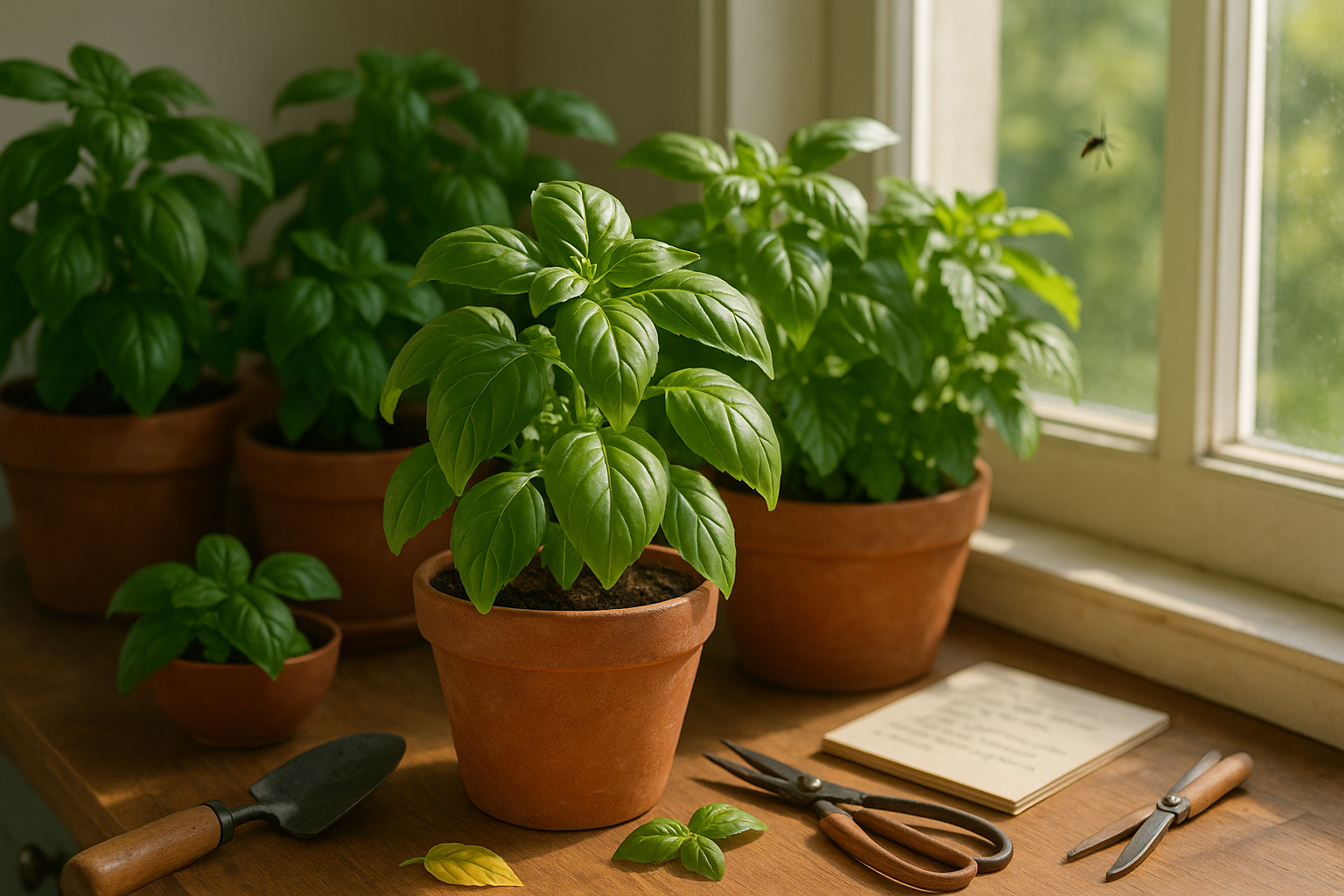Introduction
If you’ve recently noticed yellow basil leaves popping up in your garden or herb pots, you’re not alone. Yellowing is a common sign that something isn’t quite right with your beloved basil plant. While the causes can range from overwatering and nutrient deficiencies to pests or even just an aging plant, identifying the reason behind these yellow basil leaves early is key to keeping your plant healthy and thriving.
Letting the yellowing linger can lead to a rapid decline, making it harder to get your plant back on track. In this blog post, we’ll break down the most common reasons your basil leaves might be turning yellow, share easy-to-follow troubleshooting tips, and offer practical solutions—from adjusting your watering schedule to checking for bugs. With a few simple changes, you’ll have lush, green basil ready for your next recipe in no time!
Common Causes of Yellow Basil Leaves
Yellow leaves on basil plants are a common frustration for gardeners, but understanding the causes can help you quickly remedy the issue before your plant’s health declines.
Environmental stress tops the list. Basil is sensitive to both overwatering and underwatering, and it’s easy to tip the balance. If your soil stays soggy or water pools at the base of the pot, overwatering and poor drainage could be depriving roots of oxygen, causing both root rot and yellowing leaves. Conversely, letting soil dry out completely between waterings leaves the plant thirsty, which also leads to leaf discoloration.
Too much heat, intense midday sun, or cold drafts can stress basil, making leaves turn yellow at the edges or even fall off. Another culprit might be soil quality—basil thrives in nutrient-rich, well-draining soil, so compacted, depleted, or salty soil can starve roots and result in patchy yellowing.
Over-fertilization is just as harmful as neglect. Excess fertilizer can burn your basil, while not feeding it at all leaves it weak and pale. Don’t forget to check for pests like aphids or spider mites, which sap the plant’s strength and discolor leaves. Fungal and bacterial infections, often triggered by too much moisture or poor air circulation, can cause leaves to spot, yellow, and drop off.
With so many overlapping factors, diagnosing yellow basil leaves isn’t always straightforward. It’s important to inspect your growing conditions—from watering habits to light levels, soil quality, and pest presence. Observing when and where the yellowing occurs can help you identify the cause, so you can adjust your basil care and quickly get your plant back to vibrant green.
Watering Mistakes and Moisture Problems
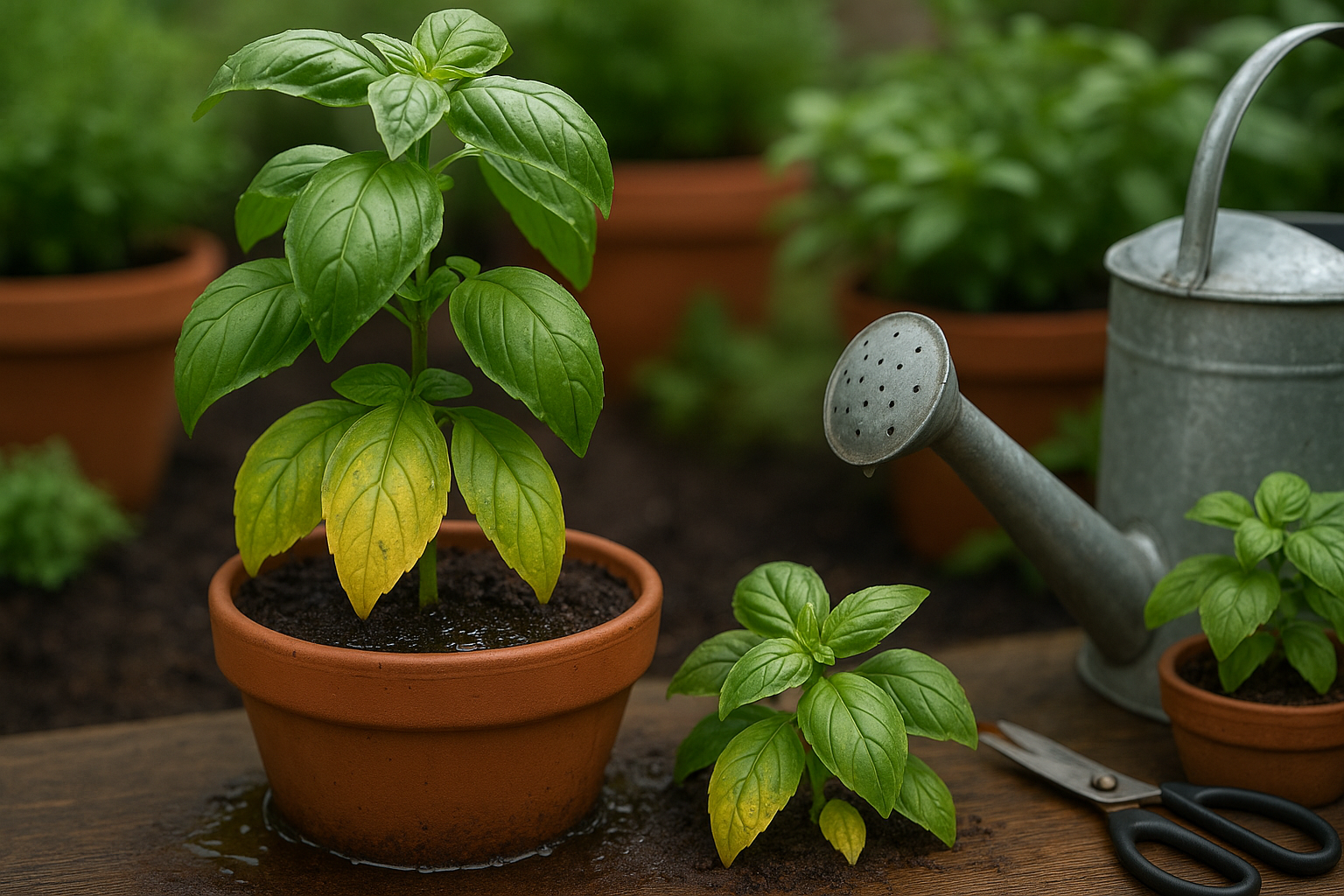
Overwatering and underwatering are two of the most common mistakes when growing basil, and both can quickly lead to unhealthy plants. Overwatering smothers basil’s roots, preventing them from getting the oxygen they need and making them susceptible to root rot—a fungal disease that starts with roots turning brown and mushy. The first visible sign is yellowing leaves, often starting from the bottom, with the plant looking wilted despite moist soil.
In contrast, underwatering leads to drought stress; basil leaves yellow and curl at the edges, becoming dry and crispy, and the whole plant may droop in midday heat.
To keep your basil thriving, tailor your watering to your setup:
- In pots, always use containers with drainage holes and let the top inch of soil dry out before watering.
- For basil in the ground, water deeply but less often, ensuring moisture reaches the root zone, especially during hot spells.
- Indoor basil usually needs less frequent watering due to lower evaporation, so check soil moisture with your finger and empty saucers after watering to prevent soggy roots.
Whether inside or outside, morning watering is best so leaves dry quickly and fungal issues are minimized. Watching your basil and adjusting watering to match the weather—more in summer heat, less during cool spells—is key to keeping your plant’s leaves lush, green, and full of flavor.
Soil & Nutrient Deficiencies
Yellowing leaves are often an early warning sign that your plant’s soil is lacking essential nutrients, especially nitrogen, iron, or magnesium. Poor soil quality—whether from overused garden beds, old potting mixes, or naturally nutrient-poor ground—struggles to nourish plants properly, and the symptoms show up fast.
If your plant’s older, lower leaves begin to yellow while veins stay green, it’s likely a nitrogen deficiency. New growth turning pale or yellow often points to iron deficiency, while yellowing between the veins of older leaves hints at a magnesium shortage.
Each element plays a key role: nitrogen boosts leafy growth, iron supports vital chlorophyll production, and magnesium helps plants turn sunlight into energy.
For fast fixes, use a balanced liquid fertilizer—look for one with micronutrients if you suspect iron or magnesium is lacking. Slow-release granular fertilizers work well for garden beds. If soil quality is chronically low, blend in fresh organic matter like compost or worm castings to boost overall fertility and structure.
For potted plants, switching out old soil for a high-quality, enriched potting mix is often the quickest solution. With garden plants, regular top-dressing with compost or slow-release fertilizer can help keep deficiencies at bay.
Remember, over-fertilizing can do more harm than good, so always follow label instructions and water well after application.
Regularly checking your soil’s health and feeding schedule ensures your plants thrive with strong green leaves, not sickly yellow ones.
Pests and Disease Issues
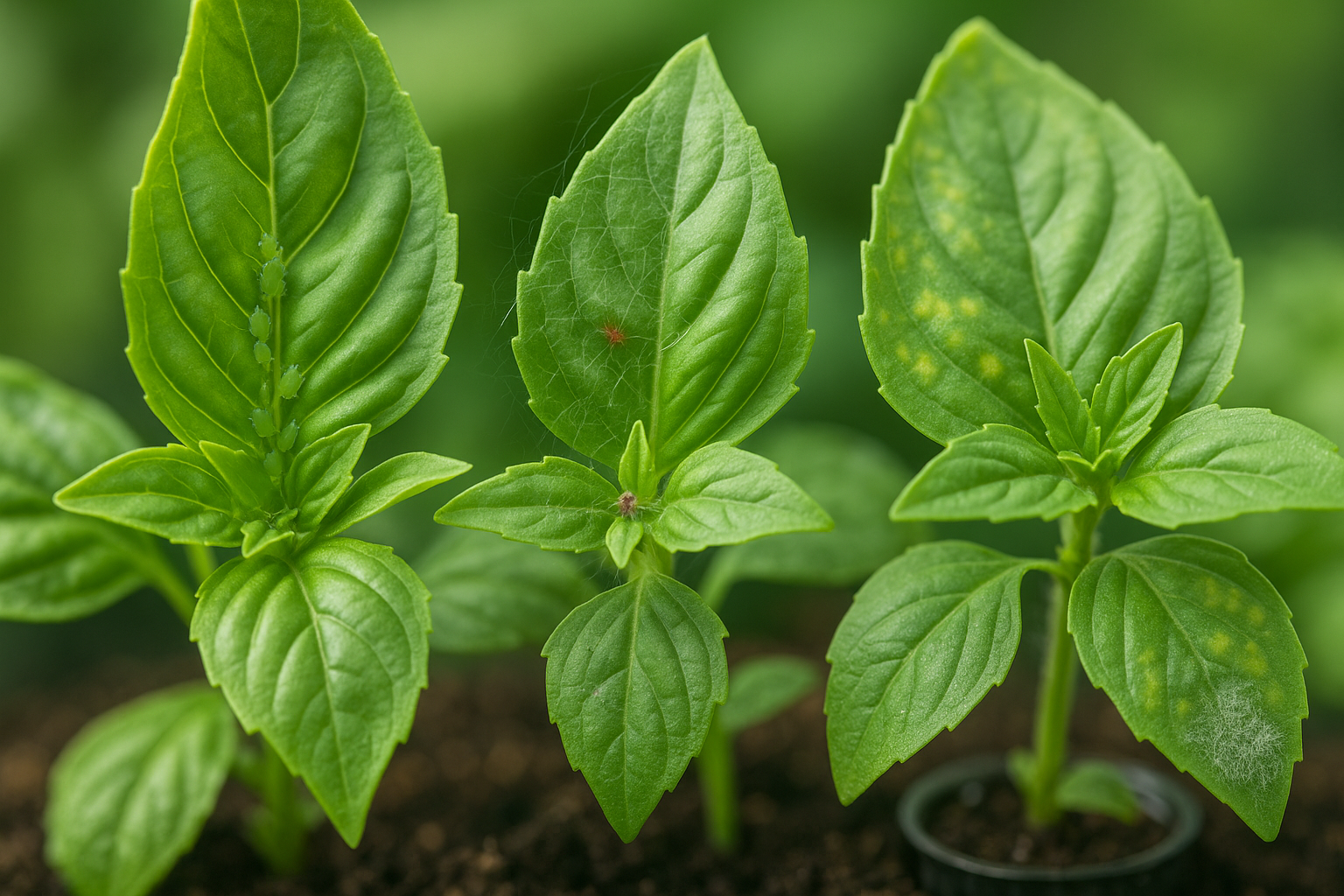
Yellowing basil leaves often indicate pesky invaders like aphids and spider mites. Aphids, tiny green or black bugs, cluster on tender shoots and the undersides of leaves, sucking plant juices and leaving sticky honeydew behind. Spider mites are harder to spot—look for fine webbing and pale speckles on leaves, which eventually turn yellow and drop.
Beyond pests, diseases can also plague basil. Fungal issues such as downy mildew appear as yellow spots on the upper leaf surfaces with fuzzy gray growth underneath, while bacterial leaf spot creates water-soaked, dark-edged spots that expand and cause leaves to yellow and wilt.
Tackling these problems organically starts with regular plant inspections—catching issues early makes a big difference. For pests, rinse leaves under a strong spray of water to knock bugs off, or use insecticidal soap made from natural oils. Ladybugs and lacewings, available at some garden centers, love to snack on aphids and offer a natural pest solution.
To prevent disease:
- Water basil at the base instead of overhead to keep foliage dry.
- Space plants for better air circulation.
- Remove infected leaves promptly.
- Grow basil in well-draining soil and avoid overcrowding to help roots stay healthy and pathogen-free.
- Rotate planting spots each season to disrupt disease cycles.
These organic habits can keep your basil lush and green all season long without resorting to harsh chemicals.
Environmental Stress Factors
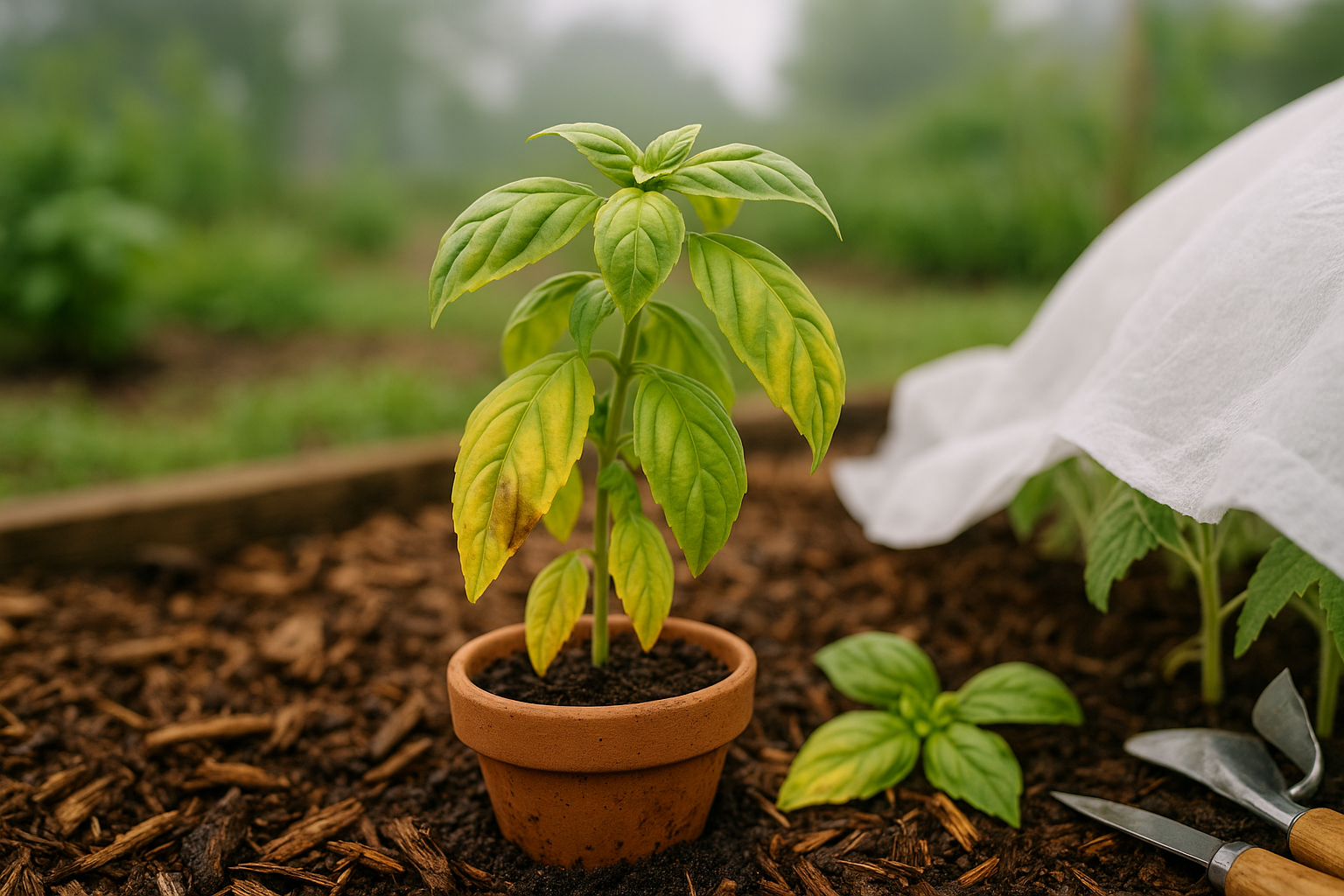
Basil is highly sensitive to its environment, and even minor stressors can quickly affect its growth and vitality. Temperature extremes—especially sudden cold snaps or scorching heat—can cause leaves to wilt, turn brown, or drop prematurely. For example, exposure to temperatures below 50°F can hinder basil’s growth, while prolonged heat without adequate moisture may scorch its leaves.
Low light is another common stressor; basil thrives on at least six hours of sunlight per day, and insufficient light leads to leggy, weak plants. Environmental changes, such as drafts or fluctuating humidity indoors, can further inhibit healthy growth.
One major challenge is transplant shock, which occurs when basil is moved from indoor seedling trays to an outdoor garden. The abrupt changes in light, temperature, and wind can stunt growth or cause leaf loss. To minimize this, gardeners should gradually acclimate—or harden off—their plants by placing seedlings outdoors for a few hours each day, slowly increasing exposure over a week.
Stabilizing conditions is key: provide basil with consistent warmth, plenty of indirect sunlight if indoors, and shelter from harsh winds outdoors. Mulching helps regulate soil moisture and temperature, while row covers can shield young plants from unexpected chills.
Regularly monitoring your basil for early signs of stress—like drooping or yellowing leaves—allows you to take quick action, such as moving the plant to a shadier spot or adjusting watering practices. By understanding and mitigating environmental stress factors, you’ll help your basil not only survive but flourish.
Quick Fixes and Long-Term Healthy Basil Care
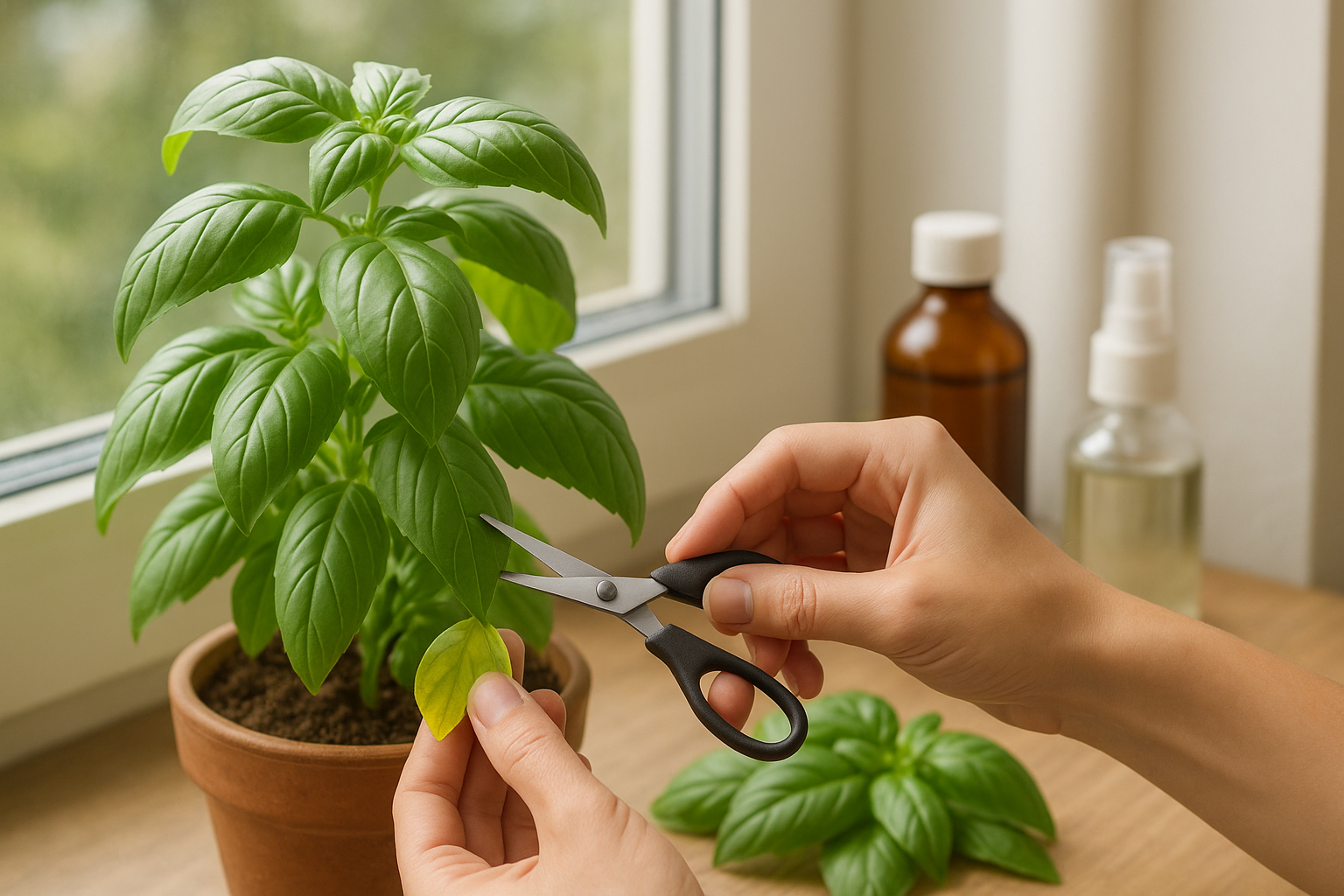
If your basil leaves are turning yellow, don’t panic—quick fixes can often set things right. Start by trimming away any yellow or damaged leaves to help the plant focus its energy on healthy growth. Check the soil moisture; basil needs consistent watering but hates soggy roots, so water only when the top inch of soil feels dry. If drainage is poor, try moving your plant to a pot with drainage holes, or add some perlite or coarse sand to improve airflow.
Sometimes yellow leaves point to nutrient deficiencies; a light dose of balanced, water-soluble fertilizer can perk things up fast, but avoid overfeeding, as too much fertilizer can cause its own problems. Next, inspect the plant for pests like aphids or spider mites—a quick blast of water or a gentle wipe with soapy water usually helps.
Long-Term Care Tips
For ongoing health, adopt habits that make tending basil easy and rewarding. Prune regularly by pinching off the top sets of leaves every week or two; this encourages bushier, more productive plants and prevents flowering, which can make the leaves bitter. Make sure your plants are spaced about 12–18 inches apart for good airflow—this reduces the risk of fungal diseases and lets sunlight reach every leaf.
Monitor your basil weekly for signs of stress, pests, or nutrient issues, so you can catch problems early. Try keeping a watering schedule or setting phone reminders to keep care consistent. Basil loves sunlight, so aim for at least six hours a day—if growing indoors, a sunny windowsill or a simple grow light will do the trick.
By making these small checks and care routines part of your week, your basil can stay green, robust, and ready to flavor your meals, whether it’s for a summertime caprese salad or a fresh batch of pesto.
Conclusion
Yellowing basil leaves are often caused by overwatering, lack of sunlight, or nutrient deficiencies. To address these issues, allow the soil to dry between waterings, place your basil in a sunny spot, and occasionally feed it with a balanced fertilizer.
Don’t worry—most basil problems can be fixed quickly once you identify the cause. With a little attention, your plant should bounce back to vibrant green in no time.
If you’re still having trouble or have a specific question, drop a comment below! We’re here to help your basil thrive, so feel free to share your experiences and tips too.
